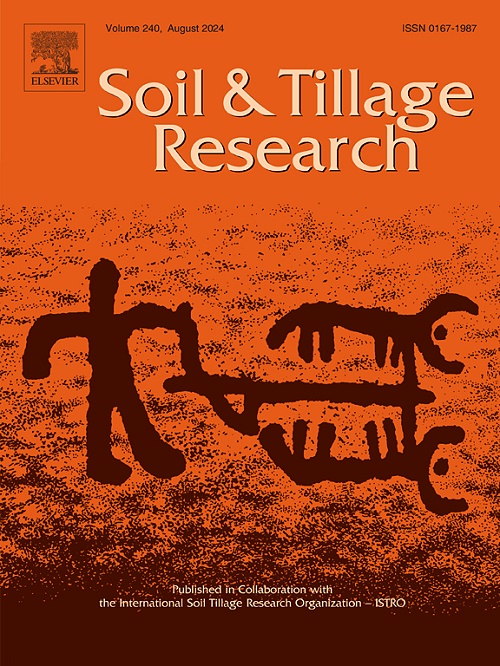Optimizing maize yield and mitigating salinization in the Yellow River Delta through organic fertilizer substitution for chemical fertilizers
IF 6.1
1区 农林科学
Q1 SOIL SCIENCE
引用次数: 0
Abstract
Improper fertilization and irrigation practices are recognized as primary contributors to the exacerbation of secondary salinization in agricultural soils. Substituting chemical fertilizers with organic fertilizers is considered an effective strategy to mitigate secondary salinization, improve saline-alkali soils, and enhance crop yields. However, the specific effects and underlying mechanisms of reducing chemical fertilizer application in combination with organic fertilizers in saline-alkali conditions remain insufficiently understood. This study focuses on summer maize grown in coastal saline-alkali areas, employing various proportions of organic fertilizer substitution (10 %, 20 %, 30 %, 40 %) to identify an optimal application model. The findings reveal that the application of organic fertilizer as a partial substitute for chemical fertilizer directly alters the contents of alkali-hydrolyzed nitrogen, available phosphorus, available potassium, and soil quality water content in different layers, which in turn affects the total absorption of nitrogen, phosphorus, and potassium to varying degrees, thereby influencing the crop's grain yield and biomass yield. Compared to the conventional use of chemical fertilizers alone, the incorporation of organic fertilizers led to changes in grain yield and biomass yield, ranging from −13.14 % to 7.14 % and −4.86 % to −8.14 %, respectively. The soil contents of alkali-hydrolyzable nitrogen, available phosphorus, and quick-acting potassium changed by −8.30 % to 1.40 %, −13.19 % to –7.81 %, and −1.81 % to 8.42 %, respectively. Additionally, the total uptake of nitrogen, phosphorus, and potassium by maize varied by −10.03 % to 7.62 %, −10.95 % to –8.93 %, and −9.64 % to 21.95 %, respectively. Significant differences were observed in maize yield, soil nutrient levels, and plant nutrient utilization rates across the different proportions of organic fertilizer substitution. Notably, the highest maize yield was achieved when the substitution proportion was 30 %, suggesting this ratio as the optimal application model for maize production in the saline-alkali soils of the Yellow River Delta. These results provide a theoretical foundation for optimizing fertilizer management in maize cultivation within saline-alkali soils.
以有机肥替代化肥优化黄河三角洲玉米产量,缓解盐渍化
不适当的施肥和灌溉方法被认为是农业土壤二次盐碱化加剧的主要原因。有机肥替代化肥被认为是缓解次生盐碱化、改善盐碱地、提高作物产量的有效策略。然而,盐碱条件下减少化肥与有机肥联合施用的具体效果和潜在机制尚不清楚。本研究以沿海盐碱区夏玉米为研究对象,采用不同比例的有机肥替代(10 %、20 %、30 %、40 %),确定最优施用模式。结果表明,有机肥部分替代化肥直接改变了不同土层碱解氮、速效磷、速效钾含量和土壤质量含水量,从而不同程度地影响氮、磷、钾的总吸收率,从而影响作物的粮食产量和生物量产量。与常规单独施用化肥相比,施用有机肥对籽粒产量和生物量产量的影响分别为- 13.14 % ~ 7.14 %和- 4.86 % ~ - 8.14 %。土壤碱解氮、速效磷和速效钾含量变化幅度分别为- 8.30 % ~ 1.40 %、- 13.19 % ~ -7.81 %和- 1.81 % ~ 8.42 %。此外,玉米对氮、磷和钾的总吸收量变化幅度分别为- 10.03 % ~ 7.62 %、- 10.95 % ~ -8.93 %和- 9.64 % ~ 21.95 %。不同有机肥替代比例对玉米产量、土壤养分水平和植物养分利用率均有显著影响。当替代比例为30 %时,玉米产量最高,表明该比例是黄河三角洲盐碱地玉米生产的最佳应用模式。研究结果为优化盐碱地玉米栽培施肥管理提供了理论依据。
本文章由计算机程序翻译,如有差异,请以英文原文为准。
求助全文
约1分钟内获得全文
求助全文
来源期刊

Soil & Tillage Research
农林科学-土壤科学
CiteScore
13.00
自引率
6.20%
发文量
266
审稿时长
5 months
期刊介绍:
Soil & Tillage Research examines the physical, chemical and biological changes in the soil caused by tillage and field traffic. Manuscripts will be considered on aspects of soil science, physics, technology, mechanization and applied engineering for a sustainable balance among productivity, environmental quality and profitability. The following are examples of suitable topics within the scope of the journal of Soil and Tillage Research:
The agricultural and biosystems engineering associated with tillage (including no-tillage, reduced-tillage and direct drilling), irrigation and drainage, crops and crop rotations, fertilization, rehabilitation of mine spoils and processes used to modify soils. Soil change effects on establishment and yield of crops, growth of plants and roots, structure and erosion of soil, cycling of carbon and nutrients, greenhouse gas emissions, leaching, runoff and other processes that affect environmental quality. Characterization or modeling of tillage and field traffic responses, soil, climate, or topographic effects, soil deformation processes, tillage tools, traction devices, energy requirements, economics, surface and subsurface water quality effects, tillage effects on weed, pest and disease control, and their interactions.
 求助内容:
求助内容: 应助结果提醒方式:
应助结果提醒方式:


